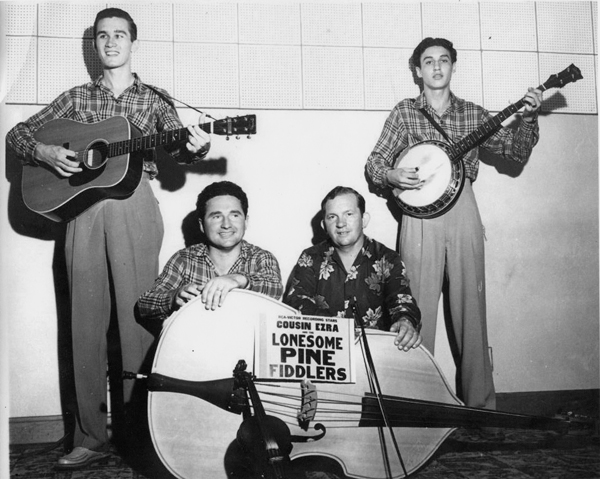On the Trail of the Lonesome Pine Fiddlers
By Bill Archer

The Lonesome Pine Fiddlers, led by Mingo County native Ezra Cline, were one of the most influential bluegrass bands in the country.
Pictured here are Mercer County natives Melvin and Ray Goins on guitar and banjo, respectively; fiddler Ray "Curly Ray" Cline, kneeling at left;
and Ezra Cline, kneeling at right; in Pikeville, Kentucky, in the mid-1950's.
Mingo County's Lonesome Pine Fiddlers didn't invent bluegrass music. But for nearly three decades, they played and sang with the best of them, introducing thousands of listeners to their exciting sound and launching the careers of some of the style's biggest stars.
Bass player Ezra Cline was the oldest member of the musically talented Cline family. Born on Gilbert Creek, January 13, 1907, he died on July 11, 1984, "within 100 feet of where he was born," according to his son, Scotty Ireland Cline. Banjo picker Ireland "Lazy Ned" Cline was born on May 3, 1921, also on Gilbert Creek. Ireland's brother, fiddler Ray "Curly Ray" Cline, was born on Gilbert Creek on January 10, 1923.
The three cousins were all fifth-generation grandsons of Nicholas and Mary Cline who, with their son Peter Cline, emigrated from Germany in about 1767. Peter Creek in Pike County, Kentucky, is reportedly named for Peter Cline. The three young musicians, along with a local guitarist named Zeke Stepp, earned a measure of popularity along Gilbert Creek and the surrounding area in the late 1930's. From the start, they performed as the Lonesome Pine Fiddlers.
“That was a group of people who really enjoyed themselves,” Lucille (Cline) Phelps of Iaeger, McDowell County, says of her childhood friends from Gilbert Creek. “My uncle Orville Cline had a little theater at the head of Gilbert Creek, where we all grew up. My dad was a cousin to Curly Ray. We all knew each other really well.”
Phelps, now 73, attended school with Curly Ray Cline. “I can still recall that little school up on Gilbert Creek where we all went,” she says. “I grew up right around the curve from the Cline boys. They were good people and good musicians. They loved to perform at that old theater on Gilbert Creek.”
Like most able-bodied young men in the coalfields, Ezra and Curly Ray went to work in the mines. “They worked almost 15 years in the mines around Gilbert Creek in Mingo County,” Scotty Cline says. “They played music, but they [also] worked in the mines.”
In 1938, the trio of Cline boys left the mines of Mingo County and headed off to Bluefield to pursue careers in music and a shot at performing live over radio station WHIS.
You can read the rest of this article in this issue of Goldenseal, available in bookstores, libraries or direct from Goldenseal.